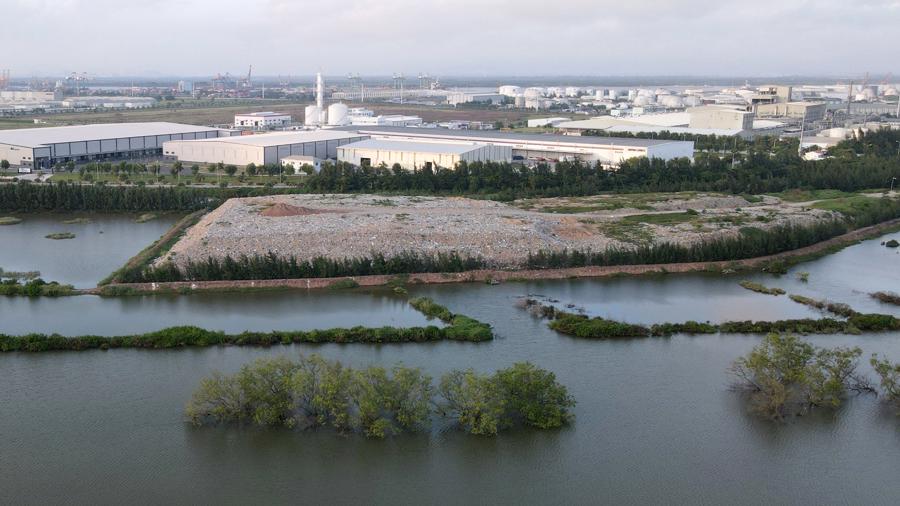Haiphong’s Industrial Park Management Board Gears Up for International Bidding to Construct a Waste-to-Energy Plant in Dinh Vu
On April 19th, Haiphong City announced its decision to delegate the Industrial Park Management Board as the inviting agency to select an investor for the construction of a waste-to-energy incineration plant in Dinh Vu, with a total investment of 2,499 billion VND.
The project, located in Ward 2, Hai An District, aims to process 1,000 tons of solid waste daily and generate approximately 20MW of electricity. Spanning an area of 10.56ha, the plant will include a construction site covering 9.54ha and a 1.02ha access road.
In line with the city’s sustainability goals, the plant will employ advanced technologies to effectively treat solid waste, conserve resources, protect the environment, and contribute to the health of the local population. Additionally, it will augment the power supply for the Vietnam Electricity Group.
The project’s primary components comprise a waste receiving bunker, an incineration system, dust and emission treatment systems, a chimney, a turbine generator, and ancillary facilities (leachate treatment, bottom ash treatment, fly ash treatment, auxiliary fuel oil tanks, transformer station, and a temporary storage for processed fly ash). The plant will also feature an operation management building, road infrastructure, and a drainage system.

The project’s lifespan is set at 30 years from the date of土地lease issuance by the Haiphong City People’s Committee. Construction is targeted for completion by December 2025, with capital contributions and fundraising to align with the construction schedule.
The Haiphong City People’s Committee has emphasized that the plant must adhere to regulatory requirements and timelines. Additionally, the technological equipment and processes used must be proven and capable of handling both unsorted and landfilled waste.
The machinery and equipment employed in the technological line must meet the project’s specifications, ensuring high levels of automation. The selection of equipment, tools, and vehicles will prioritize synchronization, be 100% new, and feature core technological components (incinerator, turbine, emission treatment devices) sourced from G7 countries or their technology transfer partners.
Throughout operations, the plant must prevent odor emissions and ensure that flue gas emissions meet or exceed the standards stipulated in QCVN 61-MT:2016/BTNMT. Treated leachate and wastewater must adhere to QCVN 40:2011/BTNMT, and after treatment, wastewater must be fully recycled within the plant, prohibiting any discharge into the environment.
Regarding fly ash, the investor must implement a technological line for its treatment, ensuring that it meets the non-hazardous waste threshold specified in QCVN 07:2009/BTNMT. The investor will assume full responsibility for the disposal of all processed fly ash and will bear all related costs. A temporary storage area will be established within the plant; however, if the investor fails to remove all the fly ash within two years, they will be subject to penalties equivalent to the cost of landfilling the generated fly ash. These penalties will be deducted from the waste treatment fees paid by the city to the investor.
The investor must also establish a processing line for bottom ash, enabling its recycling. They will be responsible for its disposal or hiring authorized entities for its collection, transportation, and treatment as per regulations.
As directed by the Haiphong City People’s Committee, the tender for the construction of the Dinh Vu waste-to-energy plant will be conducted through an international competitive bidding process. The selection of the investor is scheduled to begin in June 2024, with an anticipated outcome within 100 days.
In addition to the Dinh Vu plant, Haiphong plans to construct another waste-to-energy facility in Tran Duong Commune, Vinh Bao District. This second plant will occupy an area of approximately 10-20ha and will be procured through a similar bidding process. Its investment scale, waste treatment capacity, and power generation capabilities will be comparable to the Dinh Vu plant.
In December 2022, the Haiphong City People’s Committee released a plan for constructing waste-to-energy incineration plants, fulfilling Resolution 27/NQ-HDND of July 20, 2022, issued by the Haiphong City People’s Council. This resolution outlines comprehensive measures for waste collection, transportation, and treatment in the city from 2022 to 2025, with a vision extending to 2050. According to the plan, the Dinh Vu plant is set for completion and operation by the end of 2025, while the second plant in Tran Duong Commune, Vinh Bao District, is scheduled to commence operations in 2027.















